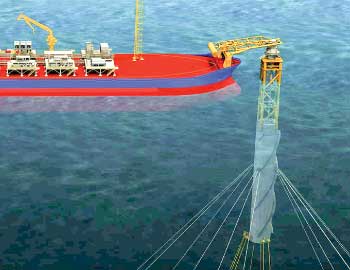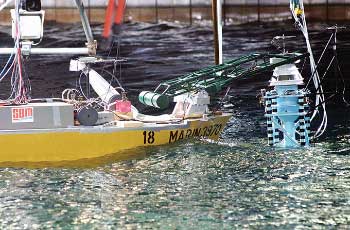By Perry A. Fischer
A new mooring system under development by SBM Atlantia solves a number of mooring issues related to extreme sea conditions, water depths and costs, says the company. The technology is not yet commercial, but is now deemed feasible. The company has been working on the concept for nearly two years, and has validated, internally, the first two phases: Concept Feasibility in 2006, and Concept Viability in 2007. The Product Definition development phase should be completed by early this summer. The next step would be a FEED study for a specific application. Engineering Project Manager Philippe Lavagna gave a presentation at OTC to show how far the development process has come, and to discuss the new system’s benefits.
The system, which is trademarked MoorSpar, is particularly well-suited to hurricane (cyclone/typhoon) prone areas such as the Gulf of Mexico, Eastern India, Western Australia and China. Its most prominent feature is the use of steel catenary risers (SCRs) for use with an FPSO in ultra-deep water, where SCRs are preferred as the cost-effective alternative to hybrid riser systems and flexible risers, especially where flexible riser/jumpers are not feasible due to high temperature/high pressure or water depth (i.e., collapse pressure). The company says that the new mooring system can also compete in shallower waters between 2,000 ft and 6,000 ft, depending on the particulars of the cost comparison.
SBM says that the system works with an FPSO where a buoy turret mooring (BTM) will not. FPSO heave motions and riser payload limit the use of SCRs with BTMs. And although BTMs are suitable for single line offset risers, they are not good for SCRs under harsh sea state and deepwater conditions. SCRs typically have limitations due to fatigue from floater heave. Thus, they are usually limited to spar-, semi- and TLP-type floaters.
According to Mr. Lavagna, “The fatigue induced by the FPSO heave motions into the SCR is typically where the FPSO’s SCR was not satisfying the acceptance specifications, which require that the overall fatigue life must greater than 10 times the field life. With this system, the FPSO motion-induced fatigue is virtually back to the case of SCRs from spars or semis, which is usually acceptable on these SCR-friendly floaters.” In the new design, SCRs move relatively little; the entire system is made of steel pipe, from the seafloor through to the FPSO-there is no need for flexible risers or jumpers.
The initial studies identified specific advantages and goals of the system: 1) provide a disconnectable mooring system, which allows an FPSO to moor in 10,000 ft and deeper water; 2) allow FPSO disconnection in hurricane conditions; and 3) obtain significant cost savings and potential operational benefits by using SCRs.
The new mooring system is essentially a truss structure set atop a slender buoy, similar to a spar, which is moored to the seafloor by a combination of lateral polyester lines and vertical tethers, Fig. 1. The FPSO connects to the buoy through a ladder-like, articulated rigid arm that contains the fluid-transfer pipes and umbilicals. The arm links to an articulated yoke system, which is connected to a main roller bearing and situated below a gimbal table at the top of the buoy unit.
 |
|
Fig. 1. SCRs proposed for use with FPSOs in harsh, hurricane-prone, ultra-deep water and a new type of buoy. The system is also suited for HPHT applications.
|
|
The arm has a counterbalanced hinge on the FPSO side that allows vertical motion, and it terminates in a cone-within-a cone clamping mechanism on the buoy side, not unlike a space-docking cone, which permits considerable misalignment while stabbing onto the gimbal, Fig. 2. The gimbal table allows yoke roll and pitch motions, while a main roller bearing below the male connection cone allows the yaw motions. This also allows the FPSO to weathervane. Structural, piping and E&I connections are located above the wave zone. The FPSO can approach without external means and connect via winch cables.
 |
|
Fig. 2. Testing the stabbing of the connection device, which is comprised of a rigid, counterbalanced arm on the FPSO, and a cone-in-a-cone connection system. There are no flexible jumpers.
|
|
The FPSO heave motions are decoupled from the SCR porches located along the buoy’s keel. This limits the vertical motion of the SCR porches to the buoy low-heave response. For a 100-year event, the buoy can move laterally 7% of the water depth; vertically, the motion is limited to about 10 m.
Specific parameters of the design study, which were modeled for the central Gulf of Mexico in 8,000 ft (2,400 m) of water, included the new API criteria for FPSOs. The FPSO was assumed to have 80,000 bopd of production, 620,000 barrels of capacity, a small-capacity bow thruster, seven SCRs and two umbilicals.
The FPSO would remain connected in a 100-year winter storm or a 100-year loop current. The FPSO would disconnect for hurricanes, but the buoy system itself is designed for a 100-year hurricane and could survive a 1,000-year hurricane. FPSO disconnection could be undertaken in up to 8-m seas, with FPSO reconnection in up to 3-m seas with the assistance of a field standby vessel. 
|




